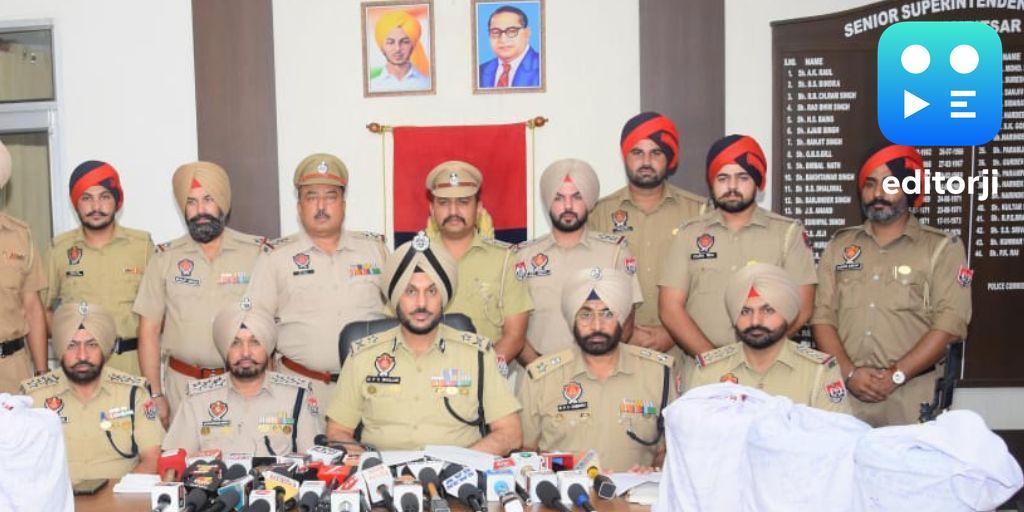Drug Lord Busted, But Cartel Still Operates Near Indo-Pak Border
Cross-Border LinksPosted by AI on 2025-07-15 16:55:42 | Last Updated by AI on 2025-08-13 08:09:30
Share: Facebook | Twitter | Whatsapp | Linkedin Visits: 7

Drug syndicates operating on a transnational scale are notoriously difficult to disrupt. Their versatile and interconnected nature means that, like a game of Whac-a-Mole, when one node is targeted, others will inevitably spring up in its place. This has been demonstrated in recent events near the India-Pakistan border.
The efforts of the Punjab Police saw the arrest of a key drug lord, identified as Ashraf Ali. Ali, a resident of Lahore, had been wanted in connection with a 2018 drug seizure, in which 3 kilograms of heroin had been intercepted on the Indian side of the border. Yet, despite this breakthrough, officers reportedly warned that the Ahmedani International Drug Cartelof which Ali is suspected of being a key playerwas likely to continue its nefarious activities.
Director General of Police (Border) S.P.S. Parmar stated that "there are many more gangs operating in Pakistan and Iran. We have specific inputs about them. We will take action against them as well." This cautionary statement highlights the increasingly precarious situation India finds itself in, wedged as it is between a heroin-producing Afghanistan and a consumption-driven Pakistan.
This recent bust has thrown up a number of questions relating not just to the particular dynamics and geography of the region, but also the challenges of combating drug cartels operating across international borders. Who are the cartels operating in this region, and how are they able to operate with such apparent impunity? Just how resilient is the infrastructure of these cartels, and what does this mean for efforts to combat drug trafficking in the region? These are questions we need to ask if we are to have any hope of providing answers.
Search
Categories
- Sports
- Business
- History
- Politics
- International
- Science & Technology
- Social Issues
- Disaster Management
- Current Affairs
- Education
- Startup Business
- Startup News
- Awards
- Community Services
- Fundraising Events
- Volunteer Services
- Health Initiatives
- Innovations and Initiatives
- In News
- dummybanners
- Awards
- Partners
- Products
- Press Releases
- News
- Fast Check
- South
- సినిమా
- Gallery
- Sunday Chronicle
- Hyderabad Chronicle
- లైఫ్ స్టైల్
- National
- క్రైం
- ట్రెండింగ్
- జాబ్స్
- అంతర్జాతీయo
- బిజినెస్
- రాజకీయం
- బిజినెస్
- సంపాదకీయం
- నవ్య
- చిత్ర జ్యోతి
- క్రీడలు
- జాతీయం
- తెలంగాణ
- తాజా వార్తలు
- మన పార్టీ
- మన నాయకత్వం
- మన విజయాలు
- డౌన్లోడ్స్
- మీడియా వనరులు
- కార్యకర్తలు
- North East Skill Center News
- Government Schemes
- Entrepreneurship Support
- Employment Opportunities
- Skill Training Programs
- Departments
- Investments
- Initiatives
- Resources
- Telangana IT Parks
- Events & Jobs
- Press Releases
- News
- Airport News
- Newtons Laws of Motion
- Karbonn in Business
- Investments in Karbonn
- Company quarterly sales
- Markets
- Auto News
- Industry
- Money
- Advertisements
- Stock target
- Company Updates
- Stock Market
- Company Sales
- Staffing and HR
- Constituency Assembly
- General News
- Srikalahasti Temple
- Bojjala Sudhir Reddy
- Technology & Innovation
- Sports
- Business
- Products
- Industries
- Services & Trainings
- Tools & Resources
- Technology Integration
- Drug Seizures & Arrests
- Telangana Narcotics
- Law & Enforcement
- Rehabilitation
- Nationwide Drug Policing
- Nigeria Seizures
- Global Operations
- Drug Awareness
- Drug Enforcement Tech
- NCB Drug Seizures
- Judicial Crackdown
- India's Surveillance Tools
- Cross-Border Links
- Women Safety
- Cyber Crimes
- Drug Abuse
- Traffic & Road Safety
- Community Connect
- Public Safety Alerts
- Citizen Assistance
- Nellore City News
- Politics & Administration
- Events & Festivals
- Agriculture & Rural
- Business & Economy
- Health & Wellness
Recent News
- Man Linked To Goldy Brar Arrested In Badshahs Chandigarh Club Blast Case
- ED Raids 15 Locations Linked To Congress MLA In Karnataka Over Illegal Mining Case
- The Simple Act of Deleting Emails Could Help Save Britain's Drought Stricken Water Supply
- New Zealand hit by 4.9 magnitude earthquake, Geonet says
- China sending signals of thawing ties with India as it lifts export curbs on Urea
- Mamaearth Parent Honasa Consumer Shares Jump 13% On Strong Q1 Results
- JSW Cement IPO Allotment Today: Check Your Status Here
- 'He Called Me A Fat...': Liam Livingstone Reveals Tom Curran's Nasty Sledge